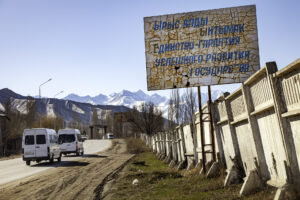At least 41 people have been killed and over 27,000 evacuated after a water dispute led to violent border clashes at the Tajik-Kyrgyz border. Novastan talked to a political scientist to understand the underlying reasons for border disputes in the region.
Since Wednesday 28 April, Tajikistan and Kyrgyzstan have engaged in border clashes of unprecedented violence in Central Asia since the collapse of the Soviet Union.
The detailed course of events differs depending on sources, but the initial trigger seemed to be the disputed use of a water supply facility located on the Kyrgyz road connecting Tajikistan to the exclave of Vorukh.
Want more Central Asia in your inbox? Subscribe to our newsletter here.
What started as usual skirmishes between local communities on April 28 turned into a large-scale conflict between armed forces of both countries the next day.
The Kyrgyz authorities announced 31 dead, including a 12-years old girl, and 132 injured. More than 27,300 people evacuated to Batken. A closed authoritarian state, Tajikistan did not communicate a death toll, but local media report eight to ten dead.
After an unsuccessful first ceasefire, both sides reached an agreement to demarcate the border on Sunday night without publishing its details.
In an interview with political scientist Parviz Mullojonov on Friday 30 April, Novastan discussed the underlying reasons for these clashes, which are common in the region but never reached such intensity. A researcher at EHESS, he has regularly worked in the area on border disputes resolution for the United Nations Development Program and International Alert, an NGO specializing in peacebuilding.
Novastan: In the Ferghana valley, borders have been disputed for a long time, with only two-thirds of the 971-kilometre Tajik-Kyrgyz border demarcated. What is the problem with the portion where the clashes started?
Parviz Mullojonov: The problem is that the demographic situation is changing, but the maps did not follow the changes since the 1920s. Tajiks are following the map of 1924-1929 when there was no Vorukh enclave. The nomadic Kyrgyz population which lives there (between the enclave and Tajikistan) has been settled. Therefore, Vorukh de facto became an enclave with Tajik population. The ownership of water and land resources was distributed and decided by Soviet authorities, and there was no significant difference. The water supply system did not take into account territorial divisions of ethnicities. Initially, it was not a problem during the Soviet Union, but because of the growing population on both sides, especially on the Tajik one, the land and water resources became a source of tensions.
Did clashes start after the collapse of the USSR?
There were already clashes during the Soviet times. The first conflict started in the Soviet Union in 1989. After this, the Soviet authorities started to pay attention. There were many commissions created, but the issue was not solved. Since then, the conflict has been in latent form for almost 23 years. There were clashes all the time, and it was not an entirely peaceful situation. The population has been living with the conflicts for decades, with people regularly arrested on both sides.
Nevertheless, before 2014, the conflicts were only between the communities, and armed forces never intervened. In 2014, border guards from both sides were involved for the first time, and the shooting started. It was already a new step when the clashes started not between the communities but also between the military people.
How did the conflict start this time?
Several days ago, the problem started with a water intake used by both sides and located on the way connecting Vorukh exclave to the mainland. There was a previous agreement between Tajikistan and Kyrgyzstan: during the wintertime until April, the Kyrgyz community would be using this water supply. From April to September, it would be used by Tajiks. In summer, the Kyrgyz side was using the Tortkulskoye water reservoir and Tajik the water supply.
This year the Tortkulskoye water reservoir lacks water, so Kyrgyz people started to take more and more from the water supply center, even if they did not have the right to do so. Tajik side opposed and believed that Kyrgyz were stealing water during the nights. Therefore, they attempted to install a security camera to check the water supply, and it caused a new conflict. Problems have accumulated for many years, and this incident was just the trigger.
The region is the target of severe droughts every year, and in general Central Asia is one of the most affected regions by climate change. Could it have amplified the problem?
Climate change probably plays some role here, because there is less water this year in the Tortkulskoye reservoir. Nevertheless, this is a long time disease because the water demand is growing with the growth of the population. Also, the population started to cultivate rice, because it is more profitable, but it demands more water. Last but not least, the Soviet irrigation system is not very efficient and requires permanent investments. It would be possible to solve this irrigation issue by building new and efficient infrastructure but it would be very expensive. Some international organisations tried to resolve the most disputed portions of land by paying for new infrastructure, but they did not have enough funds to do it all along the border. It would be the best, but there are no funds for it, nor political will on both sides.
This large-scale conflict was something that experts feared for a long time. Why didn’t Kyrgyz and Tajik governments try to resolve this resource issue before?
Neither governments have had time for that after the fall of the Soviet Union. In Tajikistan there was a civil war and then a post-conflict situation, and Kyrgyzstan there were three revolutions. On the other hand the question is difficult to resolve because it is such a complex situation. On the community level, both sides are not ready to accept any compromises.
The Kyrgyz authorities have been very active and willing to solve the border disputes since the arrival in power of Sadyr Japarov, after October’s revolution. An agreement was even found with Uzbekistan.
Actually the whole story started several weeks ago when the new Kyrgyz government decided to address the issue in order to please the public opinion and get higher ratings. They concluded an agreement with Uzbekistan which was refused by Kyrgyz locals. They tried to solve the Tajik-Kyrgyz dispute in a similar way, and started military manoeuvres at the border to put pressure. It caused a totally opposite reaction and raised tensions. Kyrgyz government did not want a new conflict, they just wanted to put pressure and to resolve the issue, but the Tajik government was not able to accept their proposal.
Could there be an exchange of territory?
It was proposed by the Kyrgyz president but it was a very rough proposal, not acceptable for Dushanbe. Even if there would be an exchange of territories, Vorukh people have to get the same infrastructure or at least to be properly reimbursed. It is not only about the buildings, but also about the gardens, the pastures, the trees, agriculture. It is a population of both farmers and traders that have cultivated the land for centuries. Therefore for them, to move to another territory is almost impossible because their whole lives and their livelihoods depend on it. Moreover, Bishkek did not propose any compensations in their proposal.
Will there be a full-scale war?
I do not think they will be a large-scale war because neither sides have the economic resources for that, at all, especially with the pandemic. In my opinion, both Bishkek and Dushanbe will try to freeze the conflict again, maybe with the help of an international mediator like Russia or Uzbekistan. Uzbekistan already got involved in negotiations, because they are afraid of a large-scale conflict in the area as there is an Uzbek minority living in Kyrgyzstan.
The majority of experts expect that they will manage to reach a deal, but on the other hand we can see that there is a public mobilisation from both sides. There are groups of young people trying to get to the borders from both sides, to “defend the country”. The governments tried not to allow them into the border area, because they know that they would lose control if they manage to get to the border. The Tajik side has more chances to succeed because it is a more centralized country with a strong government. Kyrgyzstan, after those revolutions, has more vibrant societies, and for the new government it will not be easy to control these movements.
Interview by Clara Marchaud
 What are the underlying reasons for the deadly Kyrgyz-Tajik border clashes?
What are the underlying reasons for the deadly Kyrgyz-Tajik border clashes? 



